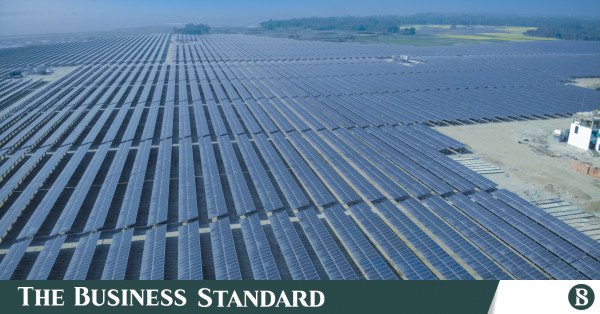Spectra has installed a 35 MW solar power park in Manikganj covering 140 acres of area to supply electricity to the national grid. The director of the company shares her motivation behind establishing the park
25 April, 2022, 09:45 am
Last modified: 25 April, 2022, 12:00 pm
As the urge to move towards a climate-friendly energy paradigm is increasingly felt every day, more and more solar power projects are being set up in Bangladesh. Spectra Solar Park Limited (SSPL) is one of the latest such projects that came online last year.
A joint venture between Spectra Engineers Limited and Shunfeng Investments Limited, a Hong Kong based company, the solar park covers an area of 140 acres in Manikganj.
The 35 MW plant has 1,37,520 solar panels and 12 central inverters – 3.125 MW each – to supply electricity to the national grid.
Originally founded by an engineer – Khan Md Aftabuddin, the chairman of Spectra Group – the group has made large investments in infrastructure, medical gas manufacturing, real estate, apparel, etc. But SSPL is the first power plant owned by the group.
So, what was the motivation behind establishing the solar power plant?
“Three things encouraged me to start a solar power plant. The first impetus is the positive impact on the environment: more than 40,000 tCo2 emission [a parameter to determine the baseline emissions in the renewable energy sector] can be saved from a 35 MW solar power plant per year. In 20 years, 8,06,000 tCo2 shall be saved.
Secondly, the tariff is commercially viable. And last but not the least, availing land for this project was easier since the project is located near the ancestral home of Spectra owners in Manikganj,” said Fatema Khan, director of Spectra Group.
Fatema Khan. Illustration: TBS
“>
Fatema Khan. Illustration: TBS
Bangladesh only has an installed capacity of 546 MW of solar power, while the total renewable energy installed capacity stands at 780.92 MW. We are far behind the government’s goal to generate 10% of the nation’s electricity from renewables by 2021. Solar power plants require a lot of land, which is scarce in this overpopulated country.
Availability of low-cost foreign funding is another challenge facing the renewable energy industry, Fatema Khan said.
In order to keep up with the country’s target without sacrificing agricultural land, Fatema proposes a number of alternatives.
“We need to use efficient and higher capacity PV panels, as it will require less area with more output. However, we should keep in mind that higher efficiency panels shall require more cost,” she said.
Utilising industry roof-tops for solar and setting up floating solar panels on river edges and water bodies are other ways to reduce pressure on agricultural land, she added.
Sharing her experience in the business aspect of solar power plants, Fatema said that in terms of profitability, for IPP (Independent Power Producer) based solar plants in Bangladesh, Project IRR (Internal Rate of Return) above 10% is good enough.
However, profitability depends on a number of factors, according to her. Firstly, good tariffs from the government. Secondly, land price, which is usually 17-20% of the project cost. There are places where land prices tend to be higher than expected. Thirdly, low-cost financing as term loans. And finally, EPC (Engineering, procurement and construction) cost. Approximately 60-65% of the project cost is EPC.
SSPL expects to reach breakeven in about seven years, the Spectra director told The Business Standard.
A tropical country, Bangladesh receives bright sunlight all year round. Big solar power plants are a relatively new phenomenon, but the country has the largest number of tiny off-grid solar home systems in the world. Yet, the country is nowhere near its full potential in terms of capturing the energy of the sun. Grid-tied roof-top solar systems for ordinary households are yet to take off due to policy constraints.
he 35 MW plant has 1,37,520 solar panels and 12 central inverters – 3.125 MW each – to supply electricity to the national grid. Photo: Courtesy
“>
he 35 MW plant has 1,37,520 solar panels and 12 central inverters – 3.125 MW each – to supply electricity to the national grid. Photo: Courtesy






















Recent Comments